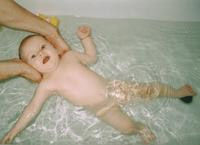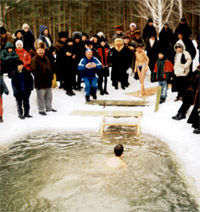Increased temperature in babies
 It is necessary to know that the temperature of a child is higher than that of an adult, which is associated with its intensive growth and constant changes in the body, including under the influence of external factors, such as sounds, touches, new impressions. So, a child’s body temperature of 37 ° C is considered normal. As a rule, it is not constant, but fluctuates around this mark. The lowest temperature is in the morning, and the highest in the evening. In addition, the temperature can change, for example, after running: in a healthy child, it rises to 37.5-37.8ºС.
It is necessary to know that the temperature of a child is higher than that of an adult, which is associated with its intensive growth and constant changes in the body, including under the influence of external factors, such as sounds, touches, new impressions. So, a child’s body temperature of 37 ° C is considered normal. As a rule, it is not constant, but fluctuates around this mark. The lowest temperature is in the morning, and the highest in the evening. In addition, the temperature can change, for example, after running: in a healthy child, it rises to 37.5-37.8ºС.
As the child grows, the baby’s body temperature stabilizes and there is no significant difference between her at rest or wakefulness. If there are any changes in the child’s behavior and it is necessary to check if he is ill, the temperature should be measured an hour after he calms down. Fever caused by the disease usually occurs in the evening, and in the morning it may not be at all. However, in some diseases, the temperature does not change throughout the day, as for example, in inflammation of the lungs.
Between a year and five children very often get sick, which means that the body adapts to various kinds of infections. This is how their immune system is formed. However, this does not mean that the disease for a child is normal and should not be treated. In order to avoid chronic diseases and other complications, the child’s body must be helped to fight infections. In any disease, the temperature always rises, which is a sign that the body is fighting the virus. That is, a fever – the body’s defensive reaction to pathogenic bacteria that die in a hot environment.
Observing the temperature changes, it is possible to follow how the disease develops. Therefore, very often, with a minor ailment, doctors do not prescribe to bring down the temperature, since it will go down by itself when the crisis of the disease passes. However, it must be borne in mind that in the case of simple forms of acute respiratory disease or tonsillitis, the temperature may be very high, whereas in severe diseases it may not exceed 38 ° C. Therefore, with any changes you need to contact a doctor.
Before the arrival of the doctor should try to bring down the temperature. This can be done with the help of wet rubdowns, which increase blood flow to the surface of the skin, and it is cooled by evaporating liquid. During rubbing, it is necessary to cover the child with a light sheet and his hands dipped in cold water, and rub his hands, forehead, legs, back and chest alternately. If the temperature does not go down after half an hour, you must give the baby a cold drink, for example, rosehip infusion, and then hold it in the bathroom with warm water for about 15 minutes. You can also try to bring the temperature down with antipyretic drugs. In infancy, give 0.08 g of baby aspirin, from one to six years – 2 tablets, and if the child is older, then 3 tablets.
Very often at high temperatures during illness children lose their appetite, especially for solid foods. Therefore, in the first days you should limit the child’s diet to drinks, such as orange or pineapple juice, which should be given to him every half hour during wakefulness. Milk can be given to a child if he is not sick after it. Vomiting after drinking milk at high temperature occurs due to the fact that the stomach does not cope with its digestion, so the baby should be fed with low-fat milk.
When a person is in such a painful state, vegetables, meat, fish, butter, and cream are also poorly absorbed. However, when the temperature of the child begins to fall, and the body recovers, it is these products, as a rule, children want most. Do not force the child to eat what he does not want during the illness, unless there is a special prescription from the doctor. It may cause vomiting or indigestion.





